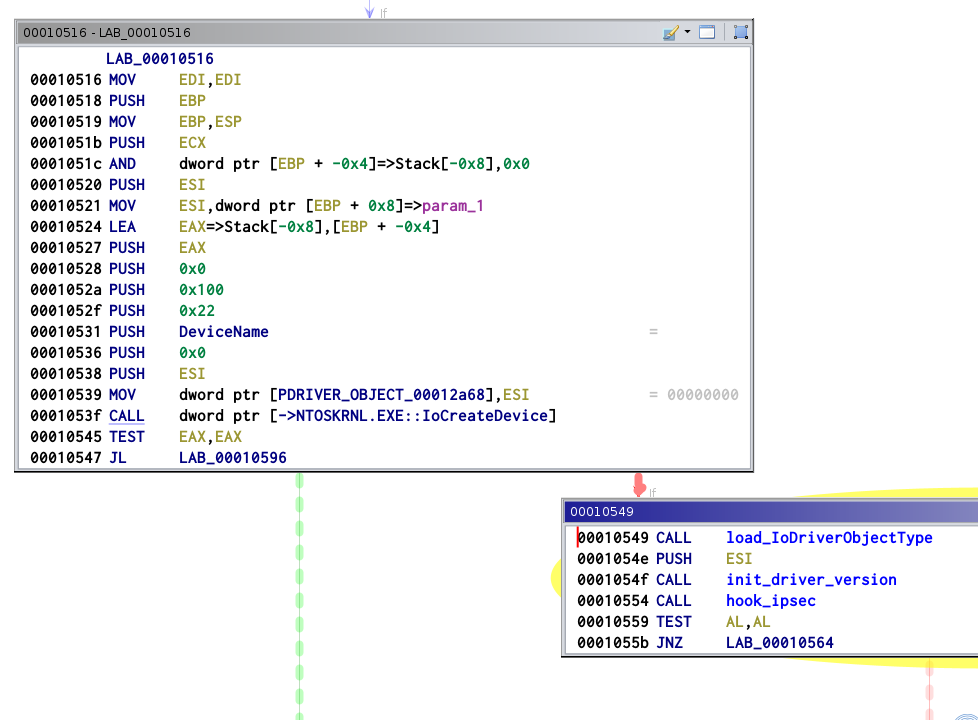
Recently I wanted to analyse some malware kernel code, so I downloaded an APT41 sample from https://vx-underground.org/.
Here are some basic infos about the sample:
Size: 12928
SHA1: a34591abefb327e3aa317ca49b0246caae8d7c5d
type: PE32 executable (native) Intel 80386, for MS Windows
I will not talk about the infection chain or APT41. It's just a technical analysis of the malware code. The sample popped on virus total during 2015 but is probably a bit older than that, as its compilation date is 2011 and because Securelist talked about a similar sample during 2013.
We'll see in the analysis that the driver targets old Windows versions, from 2000 to Vista.
The driver has two objectives, hide connections on the system, and eventually block some others. We´ll see that it achieves this by hooking very specific functions, and by initiating a cover channel with userland by adding functionalities to a syscall.
The driver starts by calling the routine IoCreateDevice with
FILE_DEVICE_UNKNOWN (0x22) as DeviceType, FILE_DEVICE_SECURE_OPEN (0x100)
as DeviceCharacteristics and \\Device\\PORTLESS_DeviceName as DeviceName.
As the created object is not used at all by the driver, we can easily guess that this is used as a mutex, just to be sure that the driver isn't loaded multiple time in memory.

Its next step is to retrieve the address of the global data IoDriverObjectType
with MmGetSystemRoutineAddress. It will use this data to find and delete
itself in the struct _LIST_ENTRY TypeList, but more on that later.
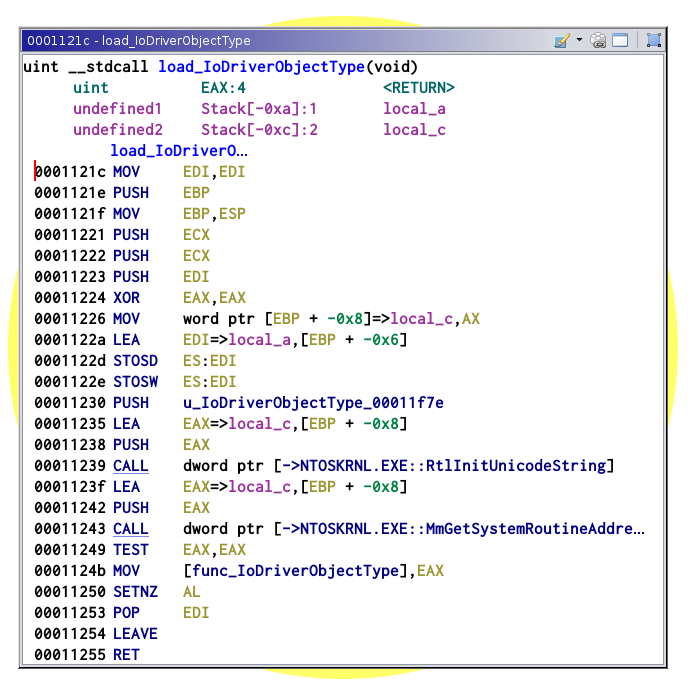
I wrote above that the driver targets multiple versions of Windows. As it will
perform precise hooking in the kernel, it needs to know the version of the
running system. This is done by retrieving the value of NtBuildNumber, and
setting global variables accordingly (some critical structures used by the
driver differs between systems). For example, _OBJECT_TYPE changed in
Windows Vista SP1. Here are the differences:
// _OBJECT_TYPE in Vista SP1
struct _OBJECT_TYPE
{
struct _LIST_ENTRY TypeList; //0x0
struct _UNICODE_STRING Name; //0x8
VOID* DefaultObject; //0x10
ULONG Index; //0x14
ULONG TotalNumberOfObjects; //0x18
ULONG TotalNumberOfHandles; //0x1c
ULONG HighWaterNumberOfObjects; //0x20
ULONG HighWaterNumberOfHandles; //0x24
struct _OBJECT_TYPE_INITIALIZER TypeInfo; //0x28
struct _ERESOURCE Mutex; //0x78
struct _EX_PUSH_LOCK TypeLock; //0xb0
ULONG Key; //0xb4
struct _EX_PUSH_LOCK ObjectLocks[32]; //0xb8
struct _LIST_ENTRY CallbackList; //0x138
};
// _OBJECT_TYPE in Win2003 SP2
struct _OBJECT_TYPE
{
struct _ERESOURCE Mutex; //0x0
struct _LIST_ENTRY TypeList; //0x38
struct _UNICODE_STRING Name; //0x40
VOID* DefaultObject; //0x48
ULONG Index; //0x4c
ULONG TotalNumberOfObjects; //0x50
ULONG TotalNumberOfHandles; //0x54
ULONG HighWaterNumberOfObjects; //0x58
ULONG HighWaterNumberOfHandles; //0x5c
struct _OBJECT_TYPE_INITIALIZER TypeInfo; //0x60
ULONG Key; //0xac
struct _ERESOURCE ObjectLocks[4]; //0xb0
};
The offset of TypeList in these two versions differs by an offset of 0x38
bytes. The driver will adjust its code regarding the Windows version.
Using these checks, we can guess that the driver is able to run on the following list of Windows versions:
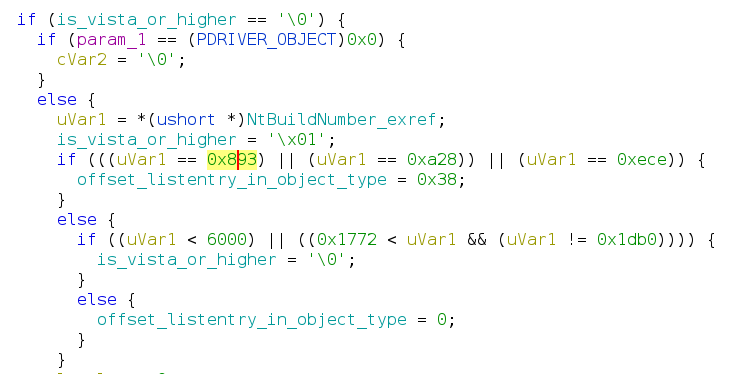
We can notice that the code adjustment for the offset of TypeList in not
properly handled in Windows Vista. Running this driver on that system probably
leads to a BSOD because of that.
Shortly after, the driver retrieves its name (function at 0x10e72) and hash
it with the following algorithm (function at 0x10df6).
sum = 0
for c in name:
sum = (sum * 3) + (sum >> 1) + c.upper()
sum %= 0x25
Everything is set up for the driver to makes hooking works. The driver will hook 3 differents functions to do its job.
IPSecHandlePacketNtDeviceIoControlFileNtSetQuotaInformationFileThis hook is probably the trickiest, as IPSecHandlePacket is not an exported function easily accessible. Its name was leaked in 2020 with the Windows XP leak.
Let's break this, step by step. The driver starts by checking the Windows system
version yet again. It is important to note that this hook is performed only
on Windows XP and Windows Server 2003. All other supported
vestions are ignored. It then looks for the driver named ipsec.sys in memory,
and retrieves its base address and size (function at 0x117bc). Then, it looks
for two specific patterns in the loaded driver, in order to locate
IPSecHandlePacket (function at 0x118a0). Finally, the driver creates a
shellcode, and write a trampoline in the target function to that shellcode
(function at 0x11b82).
Here are more details. The driver lists all loaded modules by calling
ZwQuerySystemInformation with
SystemInformationClass equal to SystemModuleInformation (0xb). The system
returns an array of _RTL_PROCESS_MODULES in a pool memory region previously
allocated by the driver with the tag Ipsp.
The driver loops over the array, looking for ipsec.sys in the member
FullPathName. When it does find it, it stores the members ImageBase and
ImageSize, and exits the function.
Now that the driver found ipsec.sys in memory, it will start looking for a
very specific pattern in it. The pattern is the following array of 5 bytes
0x8b 0x4e 0x18 0x0f 0xc9. By downloading ipsec.sys from a Windows XP
system, we quickly find the pattern.
LAB_00018a95 XREF[1]: 00018a8b(j)
00018a95 ff 0d 40 DEC dword ptr [DAT_0001fc40]
fc 01 00
LAB_00018a9b XREF[1]: 00018a93(j)
00018a9b ff 0d 38 DEC dword ptr [DAT_0001fc38]
fc 01 00
00018aa1 8b 4e 18 MOV ECX,dword ptr [ESI + 0x18]
00018aa4 0f c9 BSWAP ECX
00018aa6 b8 00 00 MOV EAX,0xf0000000
00 f0
The driver then retrieves the 4 bytes located just before the pattern. In our
case this
is the following bytes 0x38 0xfc 0x01 0x00. It then prepends the bytes
0x39 0x3d, and starts looking for this new pattern in ipsec.sys.
Again, there's only one occurence in the memory.
00012042 0f 85 9c JNZ LAB_000120e4
00 00 00
LAB_00012048 XREF[2]: 00010366(j), 0001202a(j)
00012048 39 3d 38 CMP dword ptr [DAT_0001fc38],EDI
fc 01 00
0001204e 0f 84 3c JZ LAB_00010390
e3 ff ff
00012054 33 c9 XOR ECX,ECX
By looking at the Windows 2003 source code, we can guess that the piece of
code above appears to be in the function IPSecHandlePacket.
The driver now has everything to prepare the hooking ! It allocated 0x2a bytes
using ExAllocatedPoolWithTag and the tag Tag1, then fill the memory with the
following shellcode.
0x0: pushad
0x1: pushfd
0x2: mov eax, esp
0x4: add eax, 4
0x7: push eax
0x8: call 0xaaaaaaaa
0xd: pop eax
0xe: popfd
0xf: popad
0x10: nop
0x11: nop
0x12: nop
0x13: nop
0x14: nop
0x15: nop
0x16: nop
0x17: nop
0x18: nop
0x19: nop
0x1a: nop
0x1b: nop
0x1c: nop
0x1d: nop
0x1e: nop
0x1f: nop
0x20: nop
0x21: nop
0x22: nop
0x23: nop
0x24: push 0xbbbbbbbb
0x29: ret
The driver embed a LDE (Length Disassembler Engine) in order to compute the
length of instructions in memory. The LDE is the function at 0x11a21.
The driver uses the LDE to compute the length of the instructions located at the
address of the pattern it found in IPSecHandlePacket. It needs to find the
number of bytes to copy when it'll replace the bytes with its trampoline.
The trampoline is 5 bytes, so the driver is looking for the minimal number of
bytes greater or equal to 5 that will not end in the middle of an instruction.
For example, if you want to hook the code
50 push eax
6878560000 push 0x5678
83c02a add eax, 42
You need to copy 6 bytes instead of 5, overwise you'll not be able to execute the second instruction in your hooking function.
In the driver's shellcode, the value 0xaaaaaaaa is replaced with the address
of the hook, the nop are filled with the copied bytes (that were replaced by
the trampoline), and 0xbbbbbbbb is replaced with the address right after the
trampoline. Finally, a small piece of code is added after the
stolen instruction to perform a check on the return of the hooking function.
This gives the following shellcode.
0x0: pushad
0x1: pushfd
0x2: mov eax, esp
0x4: add eax, 4
0x7: push eax
0x8: call 0x11984 // This is the call to the hook
0xd: pop eax
0xe: popfd
0xf: popad
0x10: cmp dword ptr [0x1fc38], edi // Copied instruction (erased by trampoline)
0x16: je 0x1a
0x18: cmp eax, edi // Check on the return value of the hook
0x1a: nop
0x1b: nop
0x1c: nop
0x1d: nop
0x1e: nop
0x1f: nop
0x20: nop
0x21: nop
0x22: nop
0x23: nop
0x24: nop
0x25: push 0x1204e // Return to the original function
0x2a: ret
On the other hand, the driver write the trampoline in ipsec.sys code. To do it,
it changes the bit Write Protect of the control register
CR0 to 0. According to wikipedia, when this bit is set, the CPU can't write
to read-only pages when privilege level is 0.
The hook function is pretty simple. Its parameter is an array of registers,
that is the result of the pushad instruction at the very beginning of the
shellcode. The hook checks for the value of *(ebp + 8), which is, because of
the trampoline, the first argument of the function IPSecHandlePacket. By
looking at the Windows 2003 source code, we can notice that the first parameter
of this function is a IN PUCHAR pIPHeader which is basically a raw IP header.
The hook function looks for *(pIPHeader + 0x10) and *(pIPHeader + 0xc),
which are respectively the values of IpDest and IpSrc in the header,
and compare them with some values in its .data section.
It then sets eax accordingly.
As edi is equal to 0 at the beginning of the shellcode, the check at 0x18 on
the returned value will set the ZF (ZeroFlag) if the IpDest or IpSrc match
a certain value. Looking at the Windows 2003 source code again, we can see that
in that case, IPSecRecvPacket and IPSecSendPacket are never reached.
This means that this hook acts like a very simple and very low level firewall on the system. If an IP address is added (we'll see later how) to the blocklist, the hook will reject every packet sending to or receiving from to this address.
Before starting to hook NtDeviceIoControlFile, the driver initialize a mutex
in the function at 0x11cdc, using KeInitializeMutex.
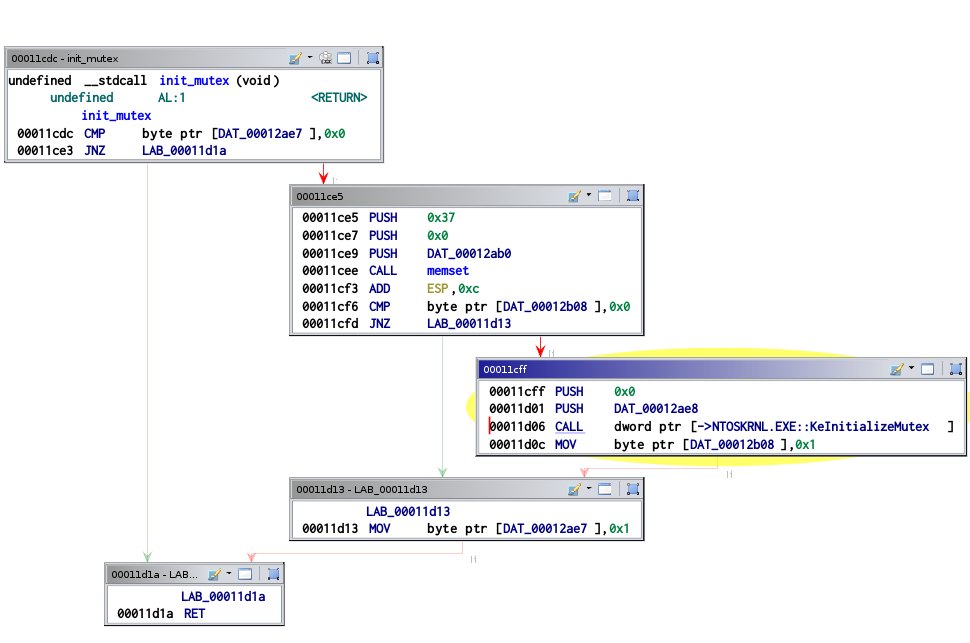
The driver retrieves the address of NtDeviceIoControlFile from its
imports and starts to look for a pattern 0x5d 0xc2 0x28 0x00 around this
address.
Here's the disassembly of NtDeviceIoControlFile on Windows XP.
nt!NtDeviceIoControlFile:
8057924a 8bff mov edi,edi
8057924c 55 push ebp
8057924d 8bec mov ebp,esp
8057924f 6a01 push 1
80579251 ff752c push dword ptr [ebp+2Ch]
80579254 ff7528 push dword ptr [ebp+28h]
80579257 ff7524 push dword ptr [ebp+24h]
8057925a ff7520 push dword ptr [ebp+20h]
8057925d ff751c push dword ptr [ebp+1Ch]
80579260 ff7518 push dword ptr [ebp+18h]
80579263 ff7514 push dword ptr [ebp+14h]
80579266 ff7510 push dword ptr [ebp+10h]
80579269 ff750c push dword ptr [ebp+0Ch]
8057926c ff7508 push dword ptr [ebp+8]
8057926f e8be6f0000 call nt!NtWriteFile+0x3340 (80580232)
80579274 5d pop ebp
80579275 c22800 ret 28h
We can see the pattern at the very end of the function. Once the driver found
this pattern, it saves the address of the original call then call the function
at 0x1111a with 3 parameters:
IoAttachDeviceByPointer.The function at 0x1111a has one purpose: finding a code cave to place the
jump to the hook function.
It achieves this by looking for the pattern 0xcccccccc around the address
passed as the second argument (in our case IoAttachDeviceByPointer). Once it
find the pattern, it will overwrite the 0xcccccccc with the following
trampoline.
0x0: 68XXXXXXXX push addr
0x5: c3 ret
The interesting trick here is the way the driver copy the trampoline in memory,
as the memory is marked as READ_ONLY. The driver will use Memory Descriptor
List to mark the memory as writable. This trick can be find on the internet
and involves calling several APIs such as IoAllocateMdl, MmBuildMdlForNonPagedPool,
and MmMapLockedPagesSpecifyCache. To make it simple, let's say that changing
memory rights involves creating a Memory Descript List using IoAllocateMdl,
then the call to MmBuildMdlForNonPagedPool is used to fill the MDL with the
physical pages number. The memory rights are changed by setting the bit
MDL_MAPPED_TO_SYSTEM_VA to the member MdlFlags of the MDL structure.
Finally, MmMapLockedPagesSpecifyCache is called to commit the change to
the virtual memory.
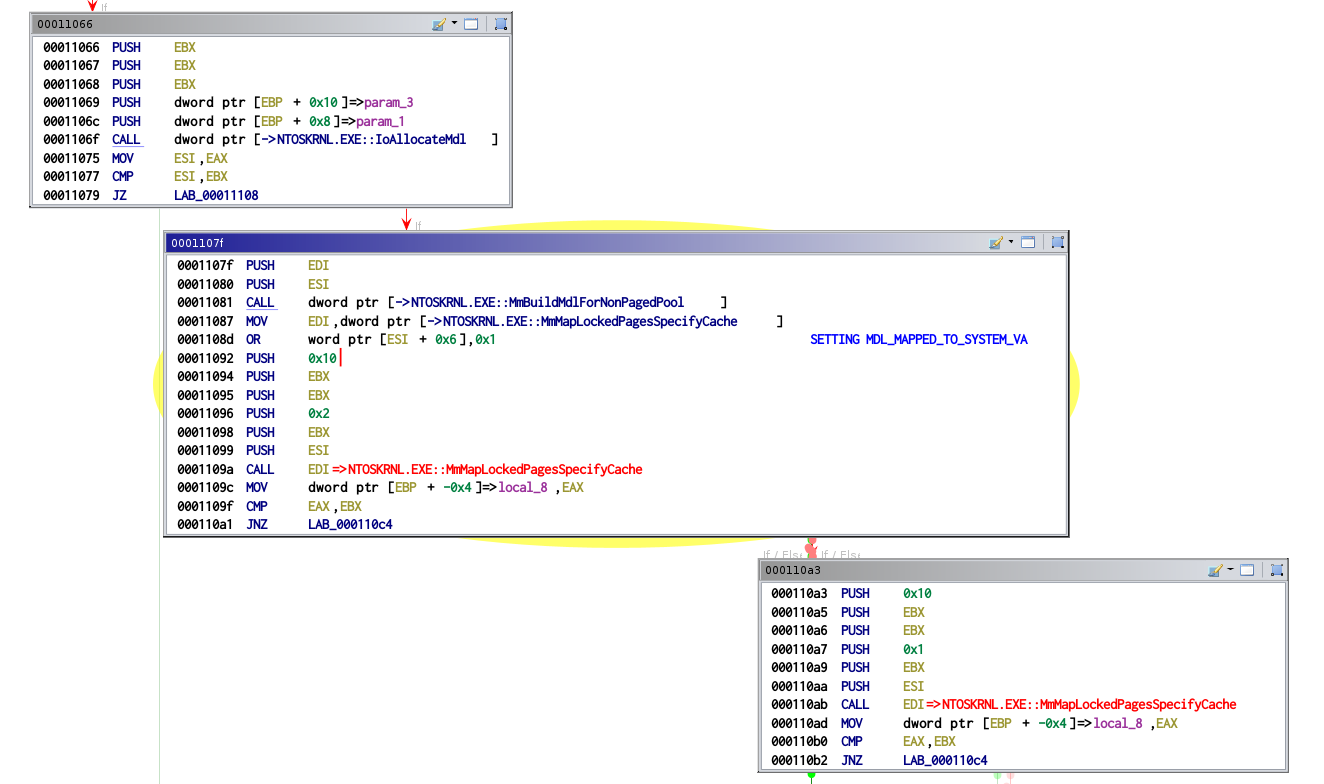
This method is used in several places in the driver's code, mostly as a memcpy
alternative on read-only memory.
The driver finally update the original call in NtDeviceIoControlFile to the
newly created trampoline.
So here's quick resume of the NtDeviceIoControlFile hook:
The driver starts by finding the address of a call to a function in the code of
NtDeviceIoControlFile. The address of this call is saved, and the driver looks
for a code cave around IoAttackDeviceByPointer. Once it's find, it writes
the trampoline in the code cave using the Memory Descriptor List trick, as the
memory is marked as READ_ONLY. Finally, it overwrite the call to a function in
NtDeviceIoControlFile by a call to the trampoline.
Let's have a look at the hook function.
The function is located at 0x10ace and starts by calling the original function.
It then checks for the Windows version, and calls the function at 0x116a6 if
the system is prior to Windows Vista. It calls 0x11702 otherwise.
These two functions are very similar, and have been written to achieve the same goal on different Windows systems.
For XP, 2003 and 2000, the function checks that the IoControlCode argument
of the function is equal to 0x120003, and that the InputBufferLength equals
0x24.
For Vista, the IoControlCode must equal 0x12001b, and InputBufferLength
must equal 0x3c.
Some checks are performed on InputBuffer inside both of the functions.
These functions check the conditions for the "real" hook function to be called. If the parameters do not pass the checks, the function return without doing anything.
The value 0x120003 corresponds to ioctl IOCTL_TCP_QUERY_INFORMATION_EX,
which is described on msdn as an operation that retrieves information from the
TCP/IP driver.
According to microsoft, the input buffer must be a pointer to the following structure
typedef struct tcp_request_query_information_ex_w2k
{
TDIObjectID ID;
uchar Context[CONTEXT_SIZE];
} TCP_REQUEST_QUERY_INFORMATION_EX_W2K, *PTCP_REQUEST_QUERY_INFORMATION_EX_W2K;
where CONTEXT_SIZE is 16, and TDIObjectID is the following.
typedef struct TDIObjectID
{
TDIEntityID toi_entity;
ulong toi_class;
ulong toi_type;
ulong toi_id;
} TDIObjectID;
typedef struct TDIEntityID
{
ulong tei_entity;
ulong tei_instance;
} TDIEntityID;
As SIZEOF(TCP_REQUEST_QUERY_INFORMATION_EX_W2K) equals 0x24. We now
understand the meaning of the inital length check, and several others (
toi_entity.tei_entity must equals 0x400 which is CO_NL_ENTITY, and
toi_id must equal 0x100, 0x102 or 0x110. These enums aren't well
documented, but are known to format the structure of output buffer).
I will not go into details of the hook, as most of the code is basically some multiple version of the same operation, duplicated because of the different structure an output buffer can be, or because of the different Windows versions supported.
The goal is simple: hide specific communication from the running system by
removing the entries in the table when a query is made. The hook function loops
over the output buffer, looking for specific IPs and ports, and will remove
these entries from the array when they are found.
For example, running the netstat command will internaly call
NtDeviceIoControlFile with IOCTL_TCP_QUERY_INFORMATION_EX as IoControlCode
, and the connections will not appear. Once again, these IPs and ports
aren't hard-coded, but are managed from userland using the last hook the driver
perform: the NtSetQuotaInformationFile hook.
This hook is the most important one, as it allows controls over the driver from userland.
Its setup is mostly the same as NtDeviceIoControlFile. This time, the driver
looks for a code cave around IoRaiseHardError and overwrite READ_ONLY
memory using the same MDL trick.
Once again, let's have a look at NtSetQuotaInformationFile on Windows XP.
nt!NtSetQuotaInformationFile:
8057b7de 8bff mov edi,edi
8057b7e0 55 push ebp
8057b7e1 8bec mov ebp,esp
8057b7e3 6a00 push 0
8057b7e5 ff7514 push dword ptr [ebp+14h]
8057b7e8 ff7510 push dword ptr [ebp+10h]
8057b7eb ff750c push dword ptr [ebp+0Ch]
8057b7ee ff7508 push dword ptr [ebp+8]
8057b7f1 e8cc5c0000 call nt!NtWriteFile+0x45d0 (805814c2)
8057b7f6 5d pop ebp
8057b7f7 c21000 ret 10h
The driver is looking for the sequence 0x5d 0xc2 0x10 0x00 which we can find
at the end of the function, and will replace the destination of the call just
before. On Windows Vista, it searches for 0x8b 0xec 0x5d 0xe9.
Let's analyze the hook function. We can notice that the function will enter the
hook only if the first parameter (HANDLE FileHandle) equals -2. If not, the
normal operation is performed.
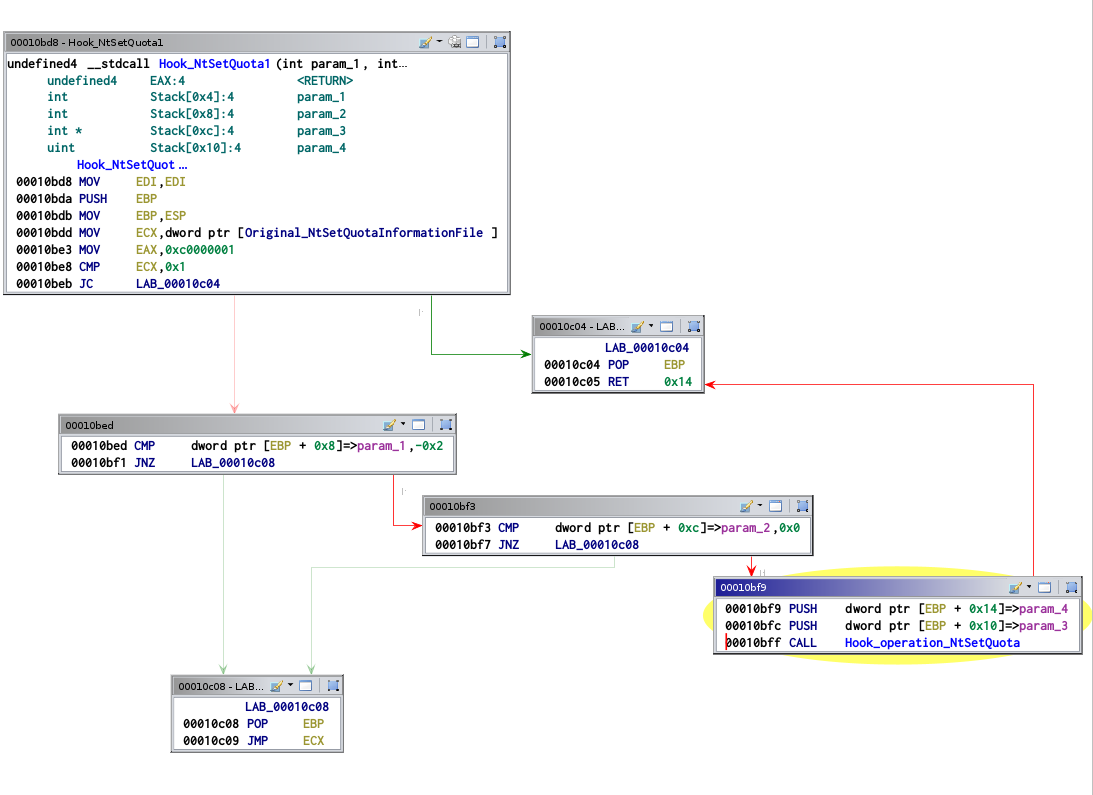
The driver simply add an operation for an existing system call. This new operation can perform the 3 following tasks:
0x1000)0x2000)0x4000).The first 4 bytes of the Buffer parameter indicates which task to perform.
Then the 4 next bytes indicates the length of the options. Then the buffer
contains N options describing informations for the different tasks.
For example, if we want to hide from the system the connection from
192.168.1.10 on port 4444, we can call the newly system call with the
following arguments NtSetQuotaInformationFile(-2, IoStatusBlock, Buffer, 14);
with buffer formatted as below.

The task 0x2000 does not take any option as parameter, and will simply remove
the driver from different linked list in memory (InLoadOrderLinks,
_OBJECT_TYPE->TypeList, \\Driver directory's object, ...).
The task 0x4000 helps adding or removing entries for the firewall database.
The entries have some uncompleted members, as they can be set but are not used
by the firewall. For example, it's possible to specify a port to the firewall,
but it will not be used. The firewall will block the corresponding IP address on
any ports.
Here are the buffer format for adding the entry 192.168.1.10 to the block
entry of the firewall.

And for removing an entry.

This sample was really cool to look at, even if it's small (~12Kb), old (2011) , and not obfuscated at all, somes of the technics used were pretty interesting. The driver was clearly in development at that time, as we noticed the unused members of the firewall's block entry structure.
Feel free to contact me if you have some questions about it :).